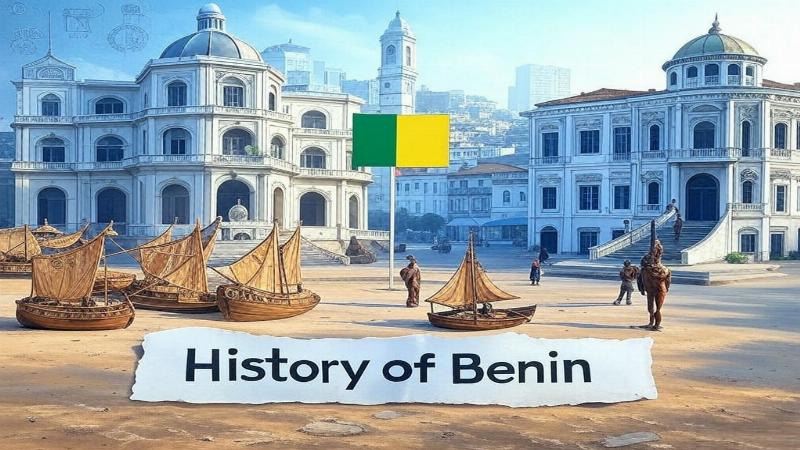Place for ads

Benin, a slender nation on West Africa’s Gulf of Guinea, is a land where history pulses through its vibrant markets and sacred groves. Covering 114,763 square kilometers, it stretches between Nigeria, Togo, Burkina Faso, and Niger, its coast once a hub of global trade. Known today for its rich culture and Vodun traditions, Benin’s past is a tapestry of ancient kingdoms, colonial scars, and a resilient spirit. In this article, we’ll explore Benin’s journey from its earliest days to its modern identity, uncovering the milestones that have shaped this dynamic nation.
Benin’s human story begins in the Paleolithic era, around 100,000 BCE, with hunter-gatherers leaving stone tools in the Atacora Mountains. By 2000 BCE, Neolithic farmers settled the savanna, growing yams and millet—finds near Parakou hint at their lives. The Iron Age (circa 500 BCE) brought metalworking, with smelting sites near Nikki showing early craftsmanship.
Bantu migrations from the east, starting around 1000 BCE, shaped Benin’s ethnic mix—Fon, Yoruba, and Adja peoples emerged, blending languages and customs. These groups farmed, fished, and traded along the Mono River, laying roots for the powerful states that would rise centuries later.
By the
Place for ads
Dahomey’s kings, like Agaja (1718–1740), expanded south, capturing Ouidah in 1727 and dominating the coast. Known for its military—the Dahomey Amazons, an all-female regiment—Dahomey traded palm oil and captives with Europeans, cementing its role in the transatlantic slave trade.
From the 16th to 19th centuries, Benin’s coast—dubbed the “Slave Coast”—was a grim nexus of commerce. Portuguese traders arrived in the 1470s, building forts like São João Baptista in Ouidah. Dahomey supplied over 1 million enslaved people, shipped to Brazil, the Caribbean, and North America, their labor fueling colonial empires.
The slave trade enriched kings but devastated communities—villages were raided, families torn apart. Resistance flared—captives rebelled on ships, and inland tribes fought back. Britain’s 1807 abolition shifted trade to palm oil, but Dahomey’s power waned as France eyed the region.
France clashed with Dahomey in the 1890s First and Second Franco-Dahomean Wars. King Behanzin resisted, burning Abomey in 1892 to defy capture, but French troops prevailed, exiling him to Martinique. By 1894, Dahomey became a French colony, part of French West Africa, with Porto-Novo as its capital.
Colonial rule exploited Benin—cotton, peanuts, and labor flowed to France. Railroads linked Cotonou to the interior, but locals faced forced work and taxes. Missionaries spread Christianity, clashing with Vodun priests, though traditional beliefs endured. Nationalism simmered, with figures like Louis Hunkanrin jailed for dissent.
Post-World War II, France’s grip weakened. In 1958, Dahomey gained autonomy within the French Community, led by Hubert Maga. Full independence came on August 1, 1960, renaming the nation Dahomey. Maga’s presidency faced ethnic rivalries—Fon, Yoruba, and Bariba vied for power— sparking coups.
The 1972 coup by Major Mathieu Kérékou toppled the government, renaming the country Benin in 1975 after the historic Bight of Benin. Kérékou’s Marxist regime nationalized industries, but economic woes and repression marked his 17-year rule, ending with 1991’s democratic shift.
Nicéphore Soglo won Benin’s 1991 election, heralding multiparty democracy—praised as a West African model. Kérékou returned in 1996, then stepped down in 2006, succeeded by Thomas Boni Yayi and, in 2016, Patrice Talon. Benin’s 12 million people now blend tradition with progress—Porto-Novo’s palaces contrast Cotonou’s bustle.
Cotton drives the economy, while tourism—Ouidah’s Door of No Return, Ganvie’s stilt village—grows. Challenges—poverty, corruption—persist, but Vodun festivals and Gelede dances thrive, a testament to cultural strength. Benin balances its past with a hopeful future.
Benin’s history is a saga of might and endurance—from Dahomey’s warriors to colonial chains, independence to renewal. Its coast whispers of lost souls, its heart beats with ancestral pride. As Benin strides forward, its legacy shines as a beacon of West African resilience.
Place for ads